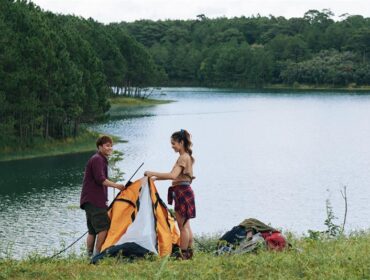So you’ve found yourself our in the great outdoors without your most basic supply: water. Apparently you didn’t use one of our camping checklists. Not to fear, with just a few supplies, you can be collecting water from natural water sources in the outdoors in no time.
Important Note: These methods are just for water collection; you will still need to sanitize the water either by boiling or using an alternative water sterilization technique.
1. Running Water
This is the most basic method for finding fresh water in the outdoors. Find a creek, river or stream and start collecting. It’s not advised to use still water like ponds or lakes because they are more likely to have dangerous bacteria or parasites like Giardia. If you don’t have access to running water, it’s time to channel your inner MacGuyver.
2. Rainwater Collection
Similar to finding running water, rainwater collection depends on at least two things: rain and something to catch it in. Just like collecting from a body of running water, this is a very simple method. Place your open container out under the sky when it’s raining. To improve the efficiency, if you have containers with large surface areas or a tarp you can use as a giant collection basin, place those out either on the ground or suspended from trees to collect even more water in less time. No rain or container? If you have a plastic bag, it will come in very handy for the third technique.
3. Plastic Bag
With just a plastic bag, you have a couple of methods of rainwater collection to choose from depending on your situation.
If you can easily dig a hole in the ground and have decent sunlight, use your plastic bag to create a solar still. Find a moist spot of ground that gets decent sunlight throughout the day, dig a hole approximately three feet across and two feet deep, put a container in the middle of the hole and cover the hole with your plastic bag. Secure the bag around the rim and place a rock in the middle. If you have access to moss or other non-poisonous foliage, place that inside your hole to increase efficiency.
The sun will create condensation from the damp ground and foliage, the condensation will collect on your bag, run down the bag thanks to the rock in the middle and drip into your container.
Unable to dig a hole? Look around for a leafy tree or shrub. For the transpiration technique, in the morning tie your bag around the branch of a tree. Use a rock inside the bag to create a low point where the water will collect. Throughout the day, the plant will transpire (it’s like sweating for plants) and the moisture will collect in your bag. The water will taste like whatever plant you’re using to collect, so again you’ll want to avoid poisonous plants.
There you have it: 3 relatively easy ways to collect water from natural water sources in the great outdoors. But do yourself a favor by using a hiking checklist and you won’t need to use any of these methods!
Featured Image from Inge Maria/Unsplash




